1. Flexible and Stretchable Electronics(Device and Circuit Integration)
1.1 Fabrication and optimization of carbon nanotube thin film transistor
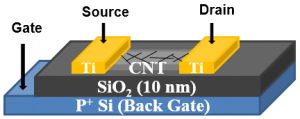 |
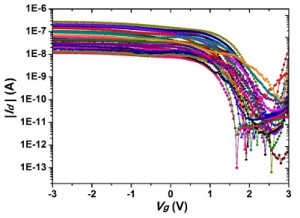 |
As the size of transistors decreases, silicon-based field-effect transistors appear inevitable short channel effect, which cannot comply with the development of Moore’s law. As a special one-dimensional material with high electron and hole mobility, carbon nanotube has become a kind of hot material to maintain Moore’s law. This project is mainly to prepare carbon nanotube thin film transistors with high performance and high mobility, and apply them to logic circuits, flexible display and biological detection.
1.2 CNT/IGZO hybrid thin film transistor
 |
At present, metal oxide semiconductor thin film transistors have attracted extensive attention, especially a-IGZO thin film transistors. Metal oxide semiconductor thin film transistors have relatively high light transmittance and higher carrier mobility than amorphous silicon thin film transistors. However, its carrier mobility is still lower than that of polycrystalline silicon thin film transistor, which still cannot meet high-performance display applications in future. In order to improve the carrier mobility of metal oxide semiconductor thin film transistors, researchers combined carbon nanotubeand metal oxides to form hybrid thin film transistors according to the excellent mechanical and electrical properties of carbon nanotube. However, at present, all manufacturing process are based on solution method, which is incompatible with the current process of industrial production of a-IGZO thin film transistors. Our current work mainly focuses on the fabrication of CNT/IGZO hybrid thin film transistors by sputtering, and studies the mechanism of carbon nanotubes improving the carrier mobility of igzo thin film transistors.
1.3 Fabrication of high speed carbon nanotube field effect transistors on flexible substrate
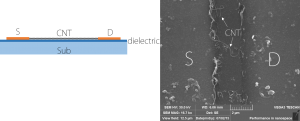 |
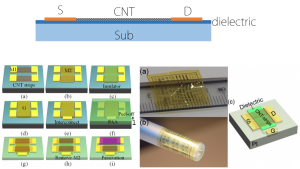 |
The directionally grown semiconductor single wall carbon nanotube is used as the active region, and titanium (gold, palladium) and other metals with good wettability are used as the source and drain electrode. The pfabrication process of the device is improved to optimize the resistance characteristics of metal and carbon nanotube heterojunction, so as to improve the mobility of the device. The directionally grown carbon nanotubes are transferred to the flexible substrate PEN by the gold transfer process, and the device fabrication (source drain electrode, gate dielectric and gate electrode) is carried out to realize the carbon nanotube field effect transistors on the flexible substrate.
1.4 Nanogenerators
 |
Triboelectric nanogenerator is a new type of generator. It can convert extremely small mechanical energy into electrical energy by Contact electrification and electrostatic induction. It has the advantages of simple manufacturing process, low cost, excellent durability and processability, and can be easily integrated into the design of other products. Combined with the advantages of high aspect ratio, large growth density and good flexibility of carbon nanotube, it is a valuable research direction to enhance power generation efficiency or broaden its application. Our current work mainly focuses on the vertical transfer of carbon nanotubes and their applications in triboelectric nanogenerators.
1.5 Flexible transistor
 |
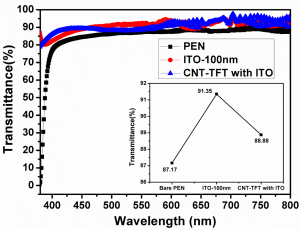 |
Fully transparent and high-performance flexible carbon nanotube thin film transistors have broad potential applications in flexible display. In order to fabricate flexible devices with high transparency, we have realized flexible carbon nanotube thin film transistors with transparency up to 91.1% and excellent electrical performance by using flexible material PEN as substrate, mature transparent electrode ITO material as drain, source and gate electrodes, and uniform carbon nanotube network as channel material.
1.6 Cell detection based on TFT
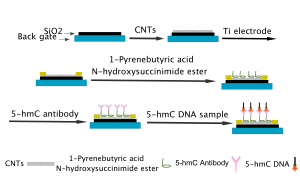 |
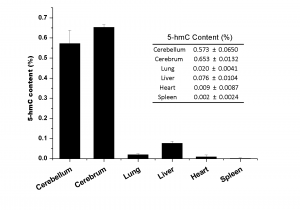 |
As an ideal one-dimensional hollow material, carbon nanotubes have large specific surface area. The one-dimensional material contains only carbon atoms, each carbon atom is on the material surface step by step, and the size of carbon atoms matches the size of DNA commonly used in biological detection. Therefore, the application of carbon nanotubes in biological detection has attracted extensive interest and attention. We have successfully used carbon nanotube thin film transistor with carbon nanotube as channel material to realize simple, sensitive and rapid detection of 5-hmc DNA. We have verified and detected the content and concentration of 5-hmc in various tissues of experimental rats, and obtained a stable concentration change curve. Among them, 5-hmc DNA is the fifth base, which plays an important role in human genetics.